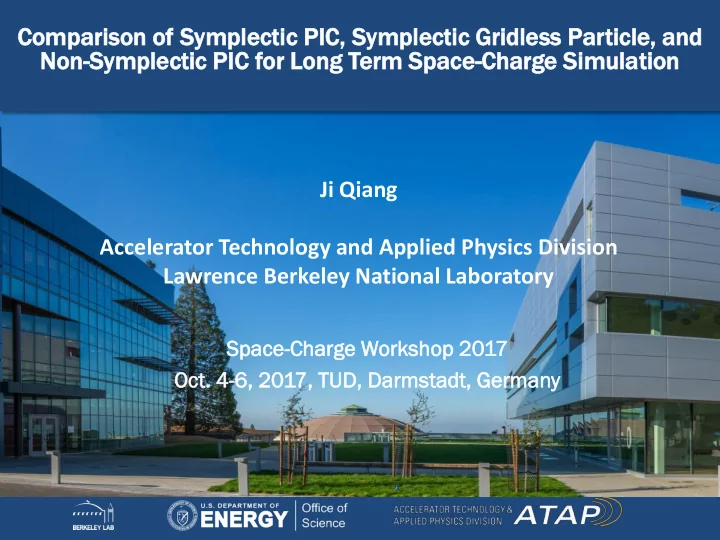

Co Comparis arison on of Symple lectic ctic PIC IC, Symplect lectic ic Gridle less ss Par Particle, le, an and Non-Sympl Symplect ectic ic PIC IC for Long Term Spac ace-Charge Charge Simula ulation tion Ji Qiang Accelerator Technology and Applied Physics Division Lawrence Berkeley National Laboratory Space ce-Char Charge ge Work rksho hop p 2017 Oc Oct. 4-6, 2017, TUD, Darmstadt, tadt, Germany
A Symplectic Multi-Particle Tracking Model (1) multi-particle Hamiltonian external focusing/acceleration space-charge Coulomb potential A formal single step solution H = H 1 +H 2 J. Qiang , “A Symplectic Multi-Particle Tracking Model for Self-Consistent Space- Charge Simulation,” Phys. Rev. ST Accel. Beams 20, 014203 (2017). 2
A Symplectic Multi-Particle Tracking Model (2) 2 nd order: 4 th order: higher order: M is the Jacobi Matrix of M Symplectic condition: Refs: E. Forest and R. D. Ruth, Physica D 43, p. 105, , 1990. . H. Yoshida, Phys. Lett. A 150, , p. 262, , 1990. . 3 3
A Symplectic Multi-Particle Tracking Model (3) M 1 • symplectic map for H 1 can be found from charged particle optics method M 2 To satisfy the symplectic condition: M 2 will be sympl mplectic ctic if p i is updated from H 2 an anal alyti ticall cally 4
Self-Consistent Space-Charge Transfer Map (1) 5
Self-Consistent Space-Charge Transfer Map (2) 6
Self-Consistent Space-Charge Transfer Map (3) 7
Symplectic Gridless Particle Model w is the particle charge weight M 2 8
Symplectic PIC Model (1) 9
Symplectic PIC Model (2) 10
Symplectic PIC Model (3) M 2 11
Non-Symplectic PIC Model 12
Benchmark Case 1: FODO Lattice, Below 2 nd Order Envelop Instability • 1 GeV proton beam • FODO lattice • 0 current phase advance: 85 degrees • Initial 4D Gaussian distribution 13
Significant Difference in Final 4D Emittances Between the Symplectic and the Non-Symplectic Methods (Strong Space-Charge: Phase Advance Change 85 -> 42) symplectic gridless symplectic PIC spectral PIC Two symplectic approaches show good agreement. 14
Final Beam X-Px Phase Spaces Have Similar Shapes Non-Symplectic Model Has Smaller Area symplectic gridless symplectic PIC spectral PIC 15
Final Y-Py Phase Space Show Similar Shapes symplectic gridless symplectic PIC spectral PIC 16
Finer Step Size Needed for Non-Symplectic PIC (Symplectic PIC vs. Non-Symplectic PIC) 1/4 step size 1/2 step size nominal step size 17
Final Transverse Phase Space: Symplectic PIC vs. Spectral PIC Symplectic PIC Spectral PIC 18
Benchmark Case 2: 1 Turn = 10 FODOs + 1 Sextupole • 0 current tune 2.417 • sextupole KL = 10 T/m/m 19
Non-Symplectic PIC Shows Much Less Emittance Growth Compared with Two Symplectic Models (4D Emittance Evolution with Different Currents) symplectic gridless symplectic PIC 30 A 20 A 10 A spectral PIC 20
Final Beam X-Px Phase Spaces Have Similar Shapes symplectic gridless symplectic PIC spectral PIC 21
Final Beam Y-Py Phase Spaces Have Similar Shapes symplectic gridless symplectic PIC spectral PIC 22
Computational Complexity • Symplectic PIC/Spetral PIC: O(Np) + O(Ng log(Ng)), parallelization can be a challenge • Symplectic gridless particle: O(Nm Np), easy parallelization Z. Liu and J. Qiang , “ Symplectic multi- particle tracking on GPUs,” submitted to Computer Physics Communications, 1997. 23
Summary Using the same step size, same number of modes, with • sufficient grid points, the symplectic PIC and the symplectic gridless particle model agree with each other very well. • Using same step size, the non-symplectic PIC yields significantly different emittance growth. All three models show similar final phase space shapes. • • Using sufficient small step size, all three methods converge to the similar emittance growth (Is this too optimistic?) • For small number of modes and particles used, the symplectic gridless particle model can be computationally efficient; otherwise, the symplectic PIC model would be more efficient. Thank You! 24
Recommend
More recommend